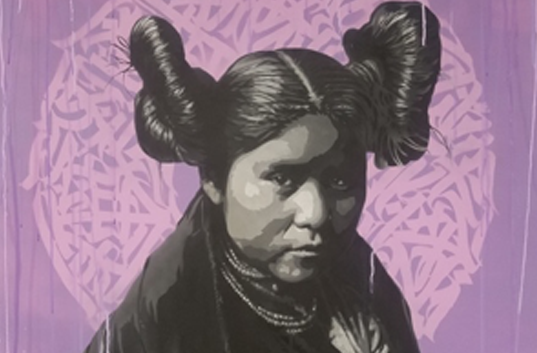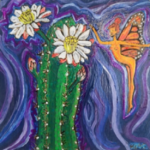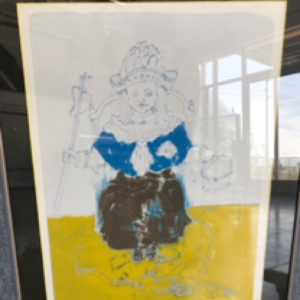

Greater Phoenix artists illustrate Arizona’s rich history through creativity
Published: 09/26/2018
Updated: 07/10/2020
In a region so focused on innovative technology and expansive growth, it’s not often we step back, and take a moment to reflect on the culture engrained within our society today. Long before a population of 4,737,270, Greater Phoenix’s history belonged to a people who paved the way for Arizona’s development, passing down their traditions, culture and legends. Today, their stories serve to highlight the challenges and opportunities that came before us, allowing us to honor the people of our past and better prepare for the future.
To remember and honor those legends, Greater Phoenix Economic Council (GPEC) is featuring artwork that depicts Arizona’s story, encouraging local artists to illustrate the journey of those that came before.
Take a look at how 16 local artists depict the folklore, myths, traditions and tall tales of Arizona’s history and work to connect those stories through art.
Nathan Benington, Tempe, AZ
We Are the Ones We Have Been Waiting For
Acrylic and spray paint, 38 x 42
He clasped his hands together, smiled and said: “…There is a river flowing now very fast. It is so great and swift that there are those who will be afraid and try to hold on to the shore… Know the river has its destination. The elders say we must let go of the shore, push off into the middle of the river, keep our eyes open and our heads above the water.
And I say, see who is in there with you and celebrate. At this time in history, we are to take nothing personally, least of all ourselves. For the moment that we do, our spiritual growth and journey come to a halt.
The time of the one wolf is over. Gather yourselves! Banish the word ’struggle’ from your attitude and your vocabulary… We are the ones we’ve been waiting for.”
—Hopi Elders’ Prophecy, June 8, 2000
Margarete Beeson, Phoenix, AZ
Cactus Blossoms
Pyrography and acrylic, 6 x 6 x 2
Desert Fairies are guardians of nature. Nurturing cacti into blossom in the harsh Arizona desert. Folklore depicts these creatures as tricksters and mischievous spirits of the night.
Stefanie J. Carson, Mesa, AZ
Soiled Doves of Tombstone
Mixed media on canvas
Life for women in the west during the late 1800s – while adventurous – was far from glamorous. During this period of time, hundreds of women descended on the town of Tombstone, Arizona hoping to marry well and create a prosperous life for themselves. Unfortunately, upon arrival most discovered few opportunities for wholesome courtship or reputable work, leaving many of these women with no other choice than to turned to the life of prostitution – her worth being minimized to a silver token and the momentary pleasure she could provide a man. While this profession was certainly not one most women would aspire to, the Soiled Doves of Tombstone bolstered the economy; their fees paid to obtain a License for Prostitution helped fund the building of local schools and churches.
Piersten Doctor, Phoenix, AZ
Bringing Forth the Day
Acrylic on canvas, 60 x 36
Bringing Forth the Day is a depiction of three Navajo deities over a gray hills style rug, performing a nine day ceremony. This piece pays tribute to the stories and traditions told by my grandparents, which have helped shape who I am today.
The Code Talker
Acrylic on canvas, 60 x 40
The Code Talker depicts a Navajo code talker over a traditional Navajo storm style rug. The lightnings represent the war and the symbol behind him represents the calm and collective mind-set one has to maintain during war – translating the code to save lives not with a gun, but with language. The radio in his hands is pushing out the signal in the form of radio waves as colored yellow and white, through the color spectrum out of the picture.
Navajo Warrior
Acrylic on canvas, 48 x 36
Navajo Warrior is inspired by my Navajo grandparents, the notorious Navajo chief Manuelito and the events of Standing Rock. The warrior that is illustrated is performing a prayer – for the earth – his words extend out to deities (Yei bi cheis), as the earth bleeds over oil.
Tal Dvir, Phoenix, AZ
The Man Beneath the Hat
Watercolor, 14 x 11
The Man Beneath the Hat is loosely based on the legendary shootout at the OK Corral in Tombstone, Arizona (1881) between the law-appointed Earp brothers and the Clanton-McLaury gang. While speculation continues as to which side fired the first shot, this dramatic event perfectly illustrates a period of the American Old West when outlaws on the frontier went virtually unopposed by law enforcement due to the scarcity of officers.
Cathy S. Hill, Tucson, AZ
Zoolights
Acrylic “dot” painting, 12 x 6
ZooLights is an annual December lighting show, which began in 1991. It is an ongoing tradition that families from around the valley enjoy each year at the Phoenix Zoo.
Allison King, Phoenix, AZ
Conflagration
Mixed media
Nobody knows what actually started the Prescott fires of 1900, but what if it was just a brazen sphinx moth drawn to flame? Conflagration is a response to the fires that destroyed mining towns at the turn of the century and the carelessness that fueled them.
Jeff Luth, Scottsdale, AZ
Ofrenda
Photography
Metal print, 16 x 24
Part of the traditional Mexican festival of Dia de los Muertos, Ofrenda represents an altar (or offering), honoring deceased loved ones.
Shane Maximus Lawson, Phoenix, AZ
The House that Built Me
Photography, 12 x 18
In the early 1870s, before paved roads and electricity found their way to Oak Creek Canyon, Bear Howard built the first hand-smoothed log cabin in the area. Howard had rightfully earned the nickname “Bear” after hunting and killing every grizzly he could find in the region as retribution for his friend who had been mauled to death. Legend has it, many of his kills were executed with only a knife. Years later, the renovated cabin would become the location on which Western author, Zane Grey, would write his aptly inspired novel, Call of the Canyon.
Spirit of the Kachina
Photography, 11 x 14
The Kachina doll is the representation of a Hopi spirit or deity. They were originally made to be given away as gifts to Hopi children to aid in teaching them the traditional and religious stories of their people. The legend mentions that each year, these holy spirits—who are believed to reside upon the San Francisco Peaks in Arizona and other sacred mountains in the Southwest—come down to the villages throughout the period from winter solstice to mid-July in the form of katsinas. They dance and sing, bring rain for the upcoming harvest and give gifts to children.
Lydia Quinones, Phoenix, AZ
Between Worlds
Multiple mediums, 2 x 5 x 9
It is said, in Yaqui culture, that there is a mystical Flower World, which is visible when the desert is in bloom. The deer is believed to bring the blessings of the “Flower World”. The deer eye, which hangs beside the ceramic deer dancer, is used to protect the wearer from evil.
Ryan Tempest, Phoenix, Arizona
Westward Ho
Pen and ink, 11 x 15 print on natural white 110# cover paper, 18 x 22 framed
The Westward Ho building is located in Downtown Phoenix on Central Avenue and Fillmore. The 16-story building was built in 1928 and was a prominent hotel through the 1950s. For years, rumors have circulated about its halls being haunted. No one can say for sure if that’s true, but its architecture alone whispers of an iconic style from long ago.
Xico, Inc., Phoenix, AZ
Since 1975, Xico, Inc. has provided opportunities for Latino and Indigenous artists to practice and grow, in addition to educational and public programs for youth and adults.
Gennaro Garcia
Maya
Monoprint
Gonzalo Gonzalez
Mano Santa
Monoprint
Tommy Martinez
Santo Nina
Monosilk
Jeffery Morris
Dia de los Muertos
Monoprint
Damian Charette, Baje Whitethorn, Jim Jackson, Jaxae and Rose Jackson
Untitled
Monoprint
When it comes to a rich and vibrant past, Greater Phoenix has no shortage of myths and tall tales. Find out more about Greater Phoenix’s culture and traditions through the region’s high quality of life. If you’re interested in purchasing the artwork featured above, contact us for more information.




















